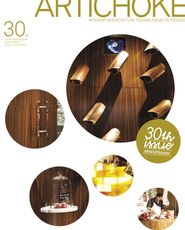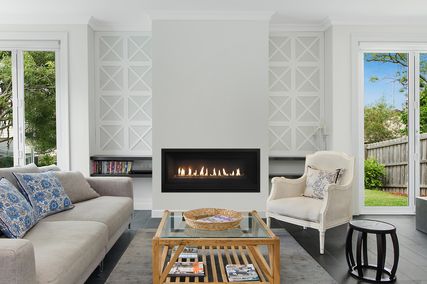In two famous foodie films, Jean-Pierre Rassam’s La Grande Bouffe (1973) and Peter Greenaway’s The Cook, the Thief, His Wife & Her Lover (1989), an unmistakable trinity is established between excess in food, behaviour and interior space. Rassam’s debauched characters fatally gorge themselves on iced architectural confections and plump tarts in the bourgeois surrounds of a French villa, while Greenaway’s internecine plots and meals take place in consistently over-scaled settings, opulent and dripping with carnal red tapestries.
Removed from cinematic hyperbole it is a familiar association. Eating – particularly eating out – is often an indulgent pleasure that deserves a correspondingly lavish setting. The accessible world of culinary travelling – tour by plat du jour – that Australians have embraced with gusto is reinforced by dining spaces that re-create or evoke exotic destinations with differing degrees of sophistication. The eating experience is effectively amplified by these design cues writ large.
This is not, however, the design equivalent of Super Size Me, Morgan Spurlock’s 2004 documentary critique of McDonald’s ploy to overfeed. As the examples reviewed in this issue demonstrate, the spatial and dimensional relationships between food and place are increasingly subtle, though there are interesting contemporary conundrums about why size really matters.
It seems that the catchment for innovative eating places has shrunk, conceptually if not demographically. As our palates have become more discerning we are less interested in menus encompassing half the globe, the palaver of à la carte or the relative safety of Modern Australian. Instead there is a proliferation of restaurants, bars and cafes that focus on a specific culinary or geographic region, and execute it with finesse. This is neither purely aesthetic impulse nor gastronomic one-upmanship (“Sardinian is the new Sicilian, darling”), but rather a response to environmental concerns and food miles, just as responsible interior design has embraced the issue of sustainable practice. There are already some restaurants touting the “100 mile principle” (or 100 kilometre if, like a relaxed cook, you aren’t too fussed about exact measure), a stance which intrinsically highlights the genius loci of the table.
Secondly, and somewhat contradictorily, once the table is located in place, its presence expands to fill the available space and to appropriate what it can of its context, whether it is an urban lane, suburban shopping mall or, as in the case of a roving restaurant van like Lord of the Fries, an opportune patch of public ground. Perhaps this is because so many new ventures are tiny hole-in-the-wall establishments, like those pioneered by Melbourne’s Six Degrees over a decade ago with the iconic Meyers Place bar. Though compact in floor area (and consequently in rent and fitout costs), these small ventures have a big impact through judicious siting, design character and the commandeering of surrounding space. Eating and drinking places that spill onto footpaths, perch on rooftops or simply open up a previously sealed industrial building to the street gain an authentic connection to a larger realm by visually and operationally meshing with it. It is quite a different tactic of theatricality from themed restaurant design, which extends the contextual frame by fantasy, illusion and window dressing.
Then there’s the phenomenon of the “big.” While dishes themselves are getting smaller – witness the prevalence of menus full of tastes or sharing plates, as well as the more traditional tapas, antipasti (now inizi) or degustation options – it’s hard to find a modern eating place that does not employ some deliberately outsized elements. Big light fittings: the haemorrhoid-like clusters of oversize bare bulbs at Melbourne’s Cumulus Inc. or the elongated timber veneer trough at Mosman’s Penny Royal. Big tables, like the expansive and communal tables of Hecker Phelan & Guthrie’s Longrain, Ivy, and Bistro Guillaume. Big chairs, in the form of continuous upholstered banquettes or island-sized ottomans for drinkers to moor themselves on. Big collections of cooking paraphernalia, like the constellation of rolling pins at Pizza Farro, the pelmet of over one thousand wine bottles at Bond Street Cafe and Wine Bar, or the complex clutter of coffee-making machinery at Outpost. And with celebrity chefs, baristas and mixologists (aka bartenders) often part of the design branding, even the personalities involved are larger than life.
Is this a perverse reflection of current debates about obesity and portion control? Should we start checking out the BMIs for the places we eat? Probably not, as most of these big gestures have the paradoxical effect of compressing and making more intimate the sociable act of dining and drinking – diners are gathered under a warm pool of light, clustered at a busy communal table and nestled up to other patrons on an uninterrupted stretch of seating. Instead of discrete tables with their own internal dynamics, conventional dining etiquette is gently dismantled. We can chat to the people near us if we wish, spy on the food they have ordered as we make our own choice, and eavesdrop on the sommelier’s recommendations. It’s a little like the way an ample one-pot dish served at the table allows us to both share and select our own portion.
The largesse of home cooking is a fruitful analogy, as many of the recent crop of influential eating places are imbued with a comforting sense of domesticity – visible work spaces, ubiquitous Thonet chairs, practical cutlery and crockery, and utilitarian stacks of glasses and cardboard boxes. Like the scale games in Alice in Wonderland, it is the exaggerated elements that lift these settings from the familiar into the heterotopic, turning them into meta-kitchens, dining rooms and tables. It is a sense of abundance rather than variety that is critical. Good restaurants, cafes and bars increasingly understand that, in food and design, the essence of great hospitality is about generosity of gesture, regardless of the scope of the menu or size of the stage.















